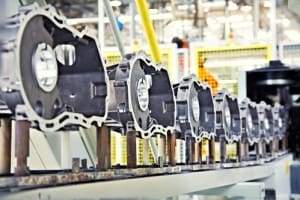
The manufacturing sector is poised to reap bigger gains with the spread of real-time data analytics being applied to material handling.
The world is in the midst of a fourth industrial revolution that integrates real-time data into manufacturing. Taking advantage of this information can give any business an edge in today’s field. It can also keep operations relevant into the future.
Performance and Product Tracking
Keeping track of your products and performance is a critical component of modern operations. Product tracking prevents inventory loss while performance tracking ensures on-time deliveries. Real-time data makes tracking much more accessible. But it requires upgrading equipment to gather the needed data.
See also: How “Machines-as-a-Service” will deliver will deliver manufacturing power in real-time
Tracking can involve monitoring the location of raw materials as they enter a facility and go through processing. It also may include information on how the finished products fare in quality control testing. Even equipment can benefit from tracking, especially regarding parts that may move around a warehouse or factory. Integrating data into warehouse operations can have benefits for today and the future.
Real-Time Data Advantages Today
Today, real-time data has practical uses in warehouses and processing facilities. For instance, batteries for forklifts can last longer when tracked. While sensors indicate when to recharge the batteries, misuse of the chargers or batteries can cause problems. Though an adequately maintained industrial battery can last up to five years, most only last one to two years. Smart chargers ensure proper charging. But you need to know when to charge the batteries. Wireless battery health monitors do this in real time. You’ll get longer life from your equipment with this real-time data tracking.
An additional advantage of real-time data today is replacing the time-consuming system of using paper tracking and manual computer input. With real-time data, you can continuously collect information. You won’t need to worry about input errors since everything is automated.
Companies today use real-time data collection and analysis to their advantage. A wireless barcode tracking system helped Amarr Garage Door to reduce its intake time from three hours to eight minutes. It also eliminated excess inventory. Under their old system, the company unknowingly retained unneeded inventory. Thanks to their new system, their operations became leaner and faster.
Future Benefits of Real-Time Data
Implementing real-time data has lasting benefits into the future. For instance, the hallmark of this data is its integration with the Internet of Things. This integration means everything is connected online, allowing for remote access from anywhere. It also permits regular software updates, so the information trackers never become outdated. Real-time updates also make the software and system safer by allowing for more frequent security updates.
Incorporating real-time data is only one step toward becoming an Industry 4.0 facility that uses the next generation of technology. With software and hardware to gather real-time data, it’s easier to upgrade to automate the facility further. Automation will make material handling faster and more accurate as it’s free of human errors.
Real-time data can prevent the most common mistakes associated with manual handling of materials. It ensures the correct products are picked and shipped every time, and quality control improves with automatic rejection of items that have not passed inspections. In the future, real-time data will enhance material handling at every step of the process by making it more accurate.
How to Get Started
To get started with gathering and using real-time data, software and hardware systems need updates. You may want to opt for web-based software, which updates continuously. Equip employees with mobile data gathering devices for collecting information about product location and status. This information uploads to the software, which can warn anyone of impending problems such as delivery delays or processing errors.
Consider the cost of a tracking system. It could range from $25,000 to $250,000, depending on the company size. Installation of such a system could take up to two years. Companies that spend time and money on a real-time data collection and tracking system can recoup their investments through the efficiency, accuracy and profitability benefits the system provides.
Integrate your real-time data tracking system with an Enterprise Resource Planning, ERP, software system. This system keeps track of the planning and financial sides of operations. Together, these systems can maximize the efficiency of a facility by making the most of the data gathered.
What’s Next?
The future of material handling is in data. The old methods of manually counting items are gone. New data collection methods and tracking systems make it easier to maintain an accurate inventory and move more efficiently. Don’t let the future pass your facility by. Incorporating real-time data will improve any material handling operation and prepare it for Industry 4.0.



























